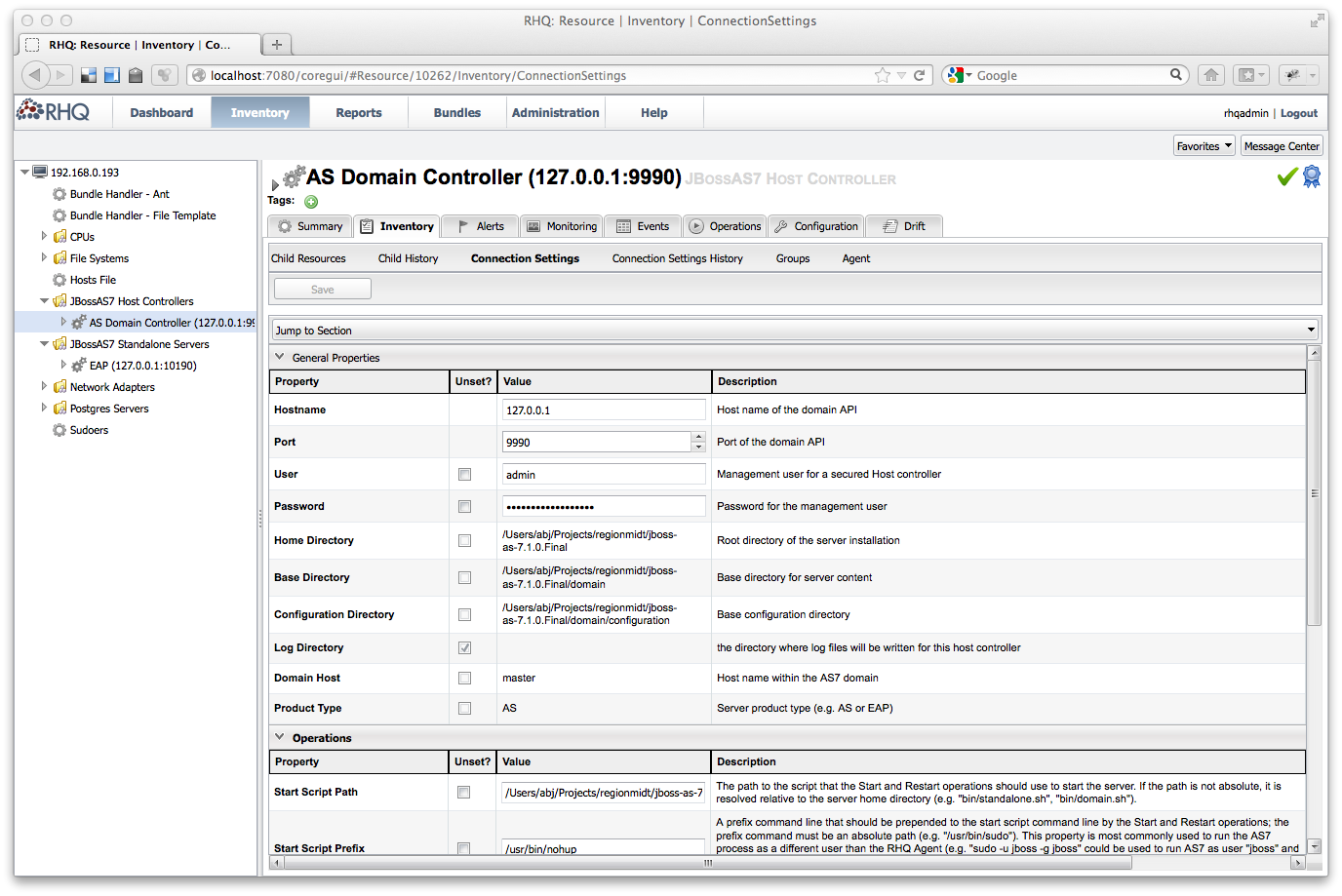cd /tmp wget http://yourrhqserver:7080/downloads/connectors/rhq-rtfilter-module.zip cd <JBOSS_HOME>/modules unzip /tmp/rhq-rtfilter-module.zip
Overview
The jboss-as-7 plugin handles discovering and managing JBoss AS 7.x and JBoss EAP/SOA-P/etc. 6.x.
JBoss AS 7.x Servers can always be auto-discovered, but in order to collect metrics and execute operations, they must have a management user configured.
Configuring a Management User
1. Add a management user to the serverinstallation.
For a standard server, this can be achieved by running ./add-user.sh in the server's bin-folder.
This will add the user to both standalone and domain configuration files.
See: https://docs.jboss.org/author/display/AS71/add-user+utility
2. Configure the management user information in RHQ
In the RHQ GUI, select the domain controller or standalone server, select the inventory tab and click "Connection Settings"
Enter the username and password for the management user and click "Save"

Enabling HTTP Response-Time Metrics
Before enabling HTTP Response-Time metric collection in your JBoss AS Server "Web Runtime" Resources, you will need to configure the RHQ RT filter module and either configure the RT filter globally (i.e. for all deployed webapps) by deploying the RT filter subsystem, or for specific webapps by updating their web.xml files.
For this to work you need to download two zip files from the RHQ Server and install them into AS7:
-
rhq-rtfilter-module.zip – Install the RT Filter Module
-
rhq-rtfilter-subsystem-module.zip – Configure RT Filter Globally
The next two paragraphs describe how to install them.
Install RT Filter Module
The filter jar is packaged as AS7 module. To configure the module in your AS7 instance, first install the jar and the associated module.xml file:
Then globally deploy the module by adding the following element as a child of the <subsystem xmlns="urn:jboss:domain:ee:1.0"> element in standalone.xml or domain.xml:
<global-modules>
<module name="org.rhq.helpers.rhq-rtfilter" slot="main"/>
</global-modules>
This should now look like this:
<subsystem xmlns="urn:jboss:domain:ee:1.0">
<global-modules>
<module name="org.rhq.helpers.rhq-rtfilter" slot="main"/>
</global-modules>
</subsystem>
In case of a later server version, this may also be urn:jboss:domain:ee:1.1 as in
<subsystem xmlns="urn:jboss:domain:ee:1.1">
<spec-descriptor-property-replacement>false</spec-descriptor-property-replacement>
<jboss-descriptor-property-replacement>true</jboss-descriptor-property-replacement>
<global-modules>
<module name="org.rhq.helpers.rhq-rtfilter" slot="main"/>
</global-modules>
</subsystem>
Also you may need to add an extension tag as in
<extension module="org.rhq.helpers.rhq-rtfilter-subsystem"/>
Configure RT Filter Globally
You can deploy the filter for all webapps or individually for selected ones - this is shown below.
To configure the filter for all deployed webapps, first install the RT filter subsystem jar and the associated module.xml file:
cd /tmp wget http://yourrhqserver:7080/downloads/connectors/rhq-rtfilter-subsystem-module.zip cd <JBOSS_HOME>/modules unzip /tmp/rhq-rtfilter-subsystem-module.zip
Then deploy the subsystem by adding the following element as a child of the <extensions> element in standalone.xml or domain.xml:
<extension module="org.rhq.helpers.rhq-rtfilter-subsystem"/>
and adding the following element as a child of the <profile> element in standalone.xml or domain.xml:
<subsystem xmlns="urn:rhq:rtfilter:1.0">
<!-- Optional parameters. Note these typically remain commented. Also,
some of these values may be configurable on the relevant "Web Runtime"
resource, via the RHQ GUI.
<init-param>
<param-name>chopQueryString</param-name>
<param-value>true</param-value>
</init-param>
<init-param>
<param-name>logDirectory</param-name>
<param-value>/tmp</param-value>
</init-param>
<init-param>
<param-name>logFilePrefix</param-name>
<param-value>localhost_7080_</param-value>
</init-param>
<init-param>
<param-name>dontLogRegEx</param-name>
<param-value></param-value>
</init-param>
<init-param>
<param-name>matchOnUriOnly</param-name>
<param-value>true</param-value>
</init-param>
<init-param>
<param-name>timeBetweenFlushesInSec</param-name>
<param-value>73</param-value>
</init-param>
<init-param>
<param-name>flushAfterLines</param-name>
<param-value>13</param-value>
</init-param>
<init-param>
<param-name>maxLogFileSize</param-name>
<param-value>5242880</param-value>
</init-param>
-->
</subsystem>
Configure RT Filter on a Per Webapp Basis
You can either configurre the filter globally as previously seen or per app. For each webapp for which you wish to configure the filter, add the following lines to the webapp's WEB-INF/web.xml then redeploy the webapp:
<!-- ===== RHQ Response Time Metric Filter ===== -->
<!-- This filter gathers response time information for processed requests -->
<!-- for all hosted applications. This requires that the -->
<!-- rhq-rtfilter-X.X.X.jar also be placed properly in the Tomcat -->
<!-- deployment. The jar file can be downloaded from the RHQ Server. -->
<!-- Using the GUI, navigate to the Administration page. Then click -->
<!-- 'Download Agent Connectors'. -->
<!-- Download connector-rtfilter.zip. Unzip to extract the jar. -->
<!-- -->
<!-- Optional parameters -->
<!-- -->
<!-- chopQueryString Filter directly chops off the query parameters -->
<!-- from the URL? Default is true. -->
<!-- -->
<!-- logDirectory Directory to which the logs are written. -->
<!-- -->
<!-- logFilePrefix Prefix to written logfile names. -->
<!-- -->
<!-- dontLogRegEx Patterns that should not be logged. -->
<!-- -->
<!-- matchOnUriOnly Apply the dontLog pattern to the URI only? -->
<!-- -->
<!-- timeBetweenFlushesInSec -->
<!-- Seconds between auto flushes of the logfile. -->
<!-- maxLogFileSize The maximum allowed size, in bytes, of the -->
<!-- logfiles if a logfile exceeds this limit, the -->
<!-- filter will truncate it; the default value is -->
<!-- 5242880 (5 MB) -->
<!-- vHostMappingFile Name of vhost mapping file. This properties file -->
<!-- must be in the Tomcat process classpath. -->
<!-- -->
<filter>
<filter-name>RhqRtFilter</filter-name>
<filter-class>org.rhq.helpers.rtfilter.filter.RtFilter</filter-class>
<!-- Optional parameters. Note these typically remain commented. Also,
some of these values may be configurable on the relevant "Web Runtime"
resource, via the RHQ GUI.
<init-param>
<param-name>chopQueryString</param-name>
<param-value>true</param-value>
</init-param>
<init-param>
<param-name>logDirectory</param-name>
<param-value>/tmp</param-value>
</init-param>
<init-param>
<param-name>logFilePrefix</param-name>
<param-value>localhost_7080_</param-value>
</init-param>
<init-param>
<param-name>dontLogRegEx</param-name>
<param-value></param-value>
</init-param>
<init-param>
<param-name>matchOnUriOnly</param-name>
<param-value>true</param-value>
</init-param>
<init-param>
<param-name>timeBetweenFlushesInSec</param-name>
<param-value>73</param-value>
</init-param>
<init-param>
<param-name>flushAfterLines</param-name>
<param-value>13</param-value>
</init-param>
<init-param>
<param-name>maxLogFileSize</param-name>
<param-value>5242880</param-value>
</init-param>
-->
</filter>
<!-- ===== RHQ Response Time Metric Filter Mapping ===== -->
<!-- To limit to only certain applications various filters can be -->
<!-- defined. This will perform RT metric collection for all -->
<!-- applications. -->
<filter-mapping>
<filter-name>RhqRtFilter</filter-name>
<url-pattern>/*</url-pattern>
</filter-mapping>
Restart JBoss AS
After installing the filter module and/or filter subsystem, JBoss AS must be restarted to pick up the changes.